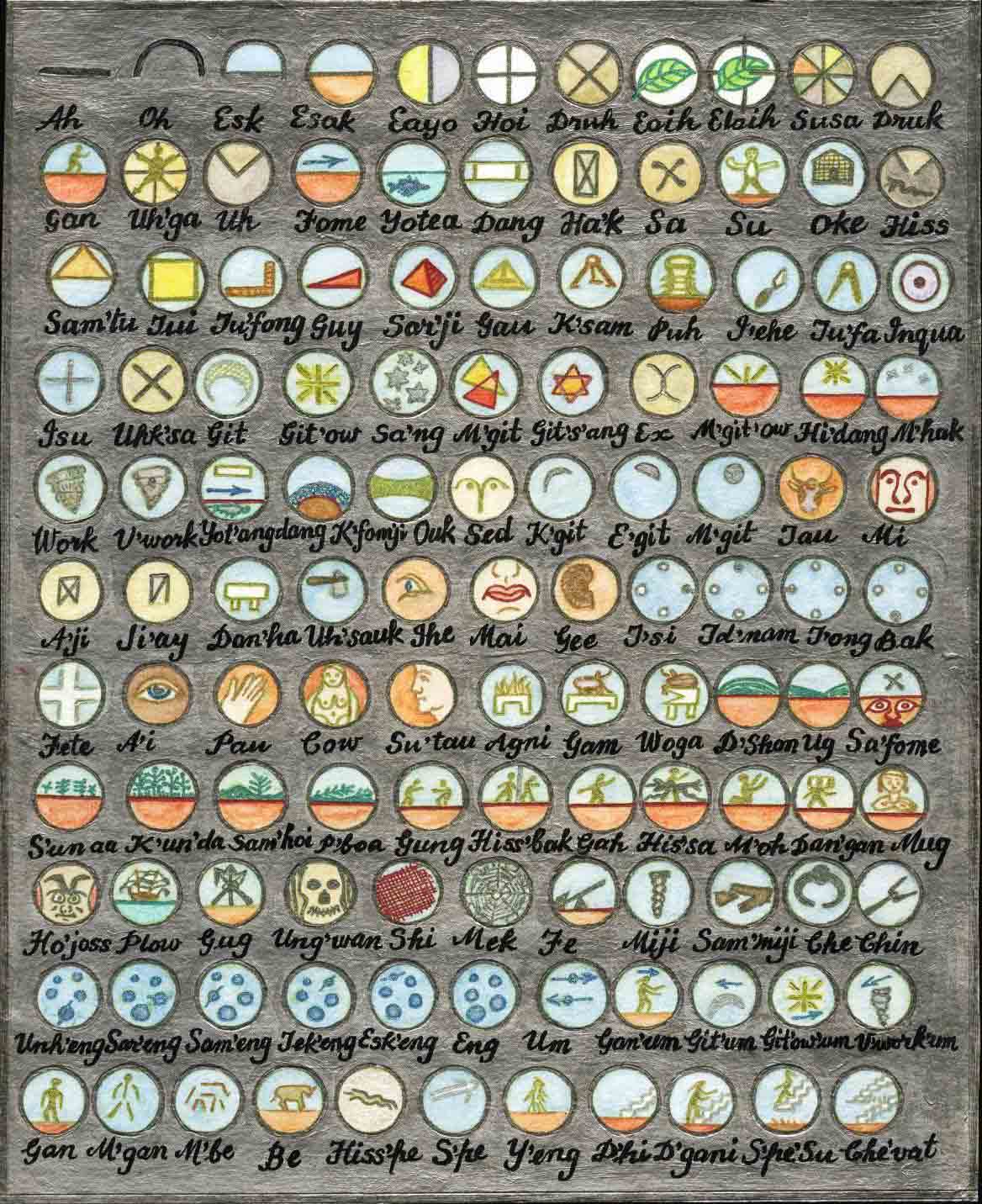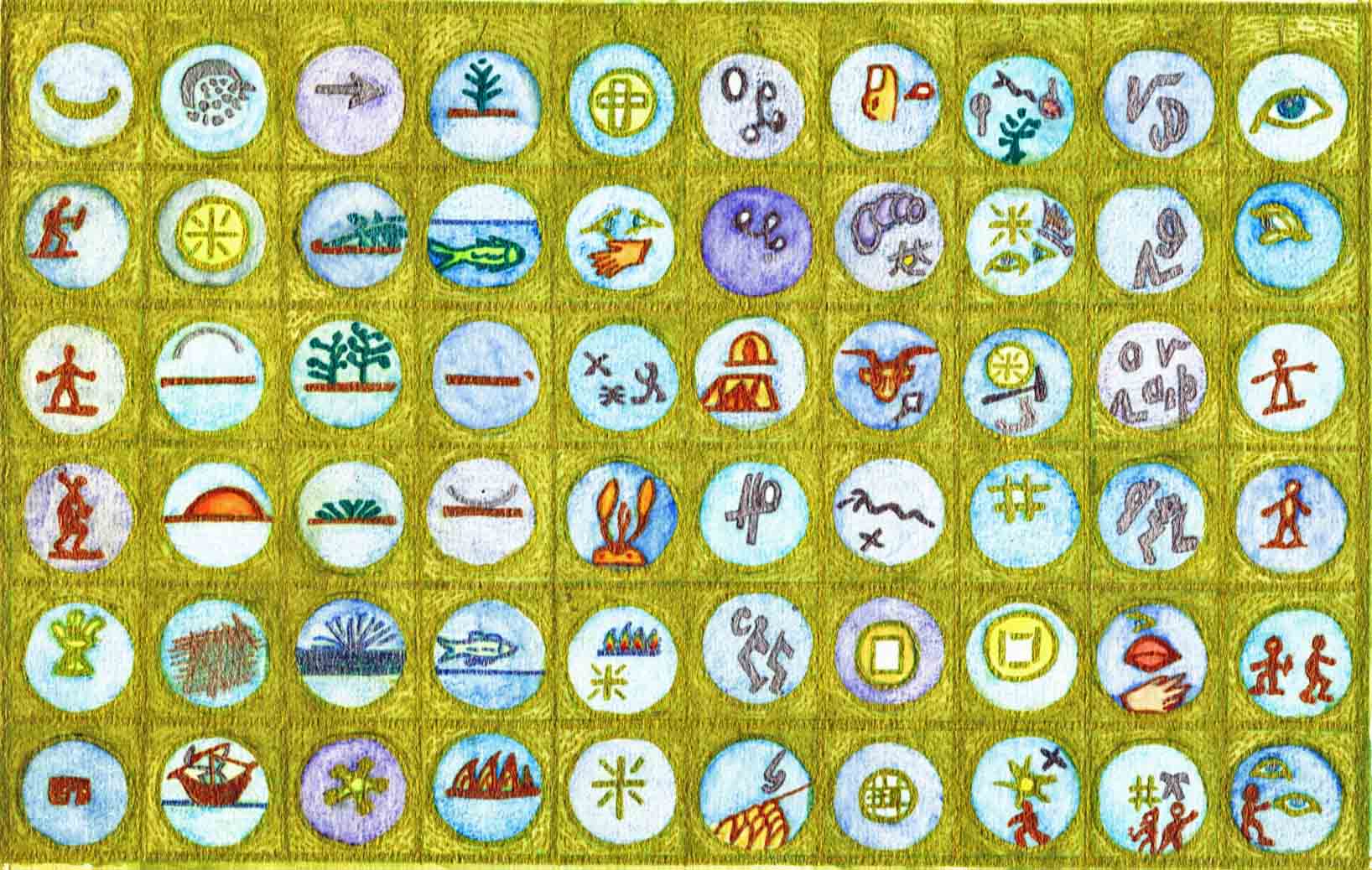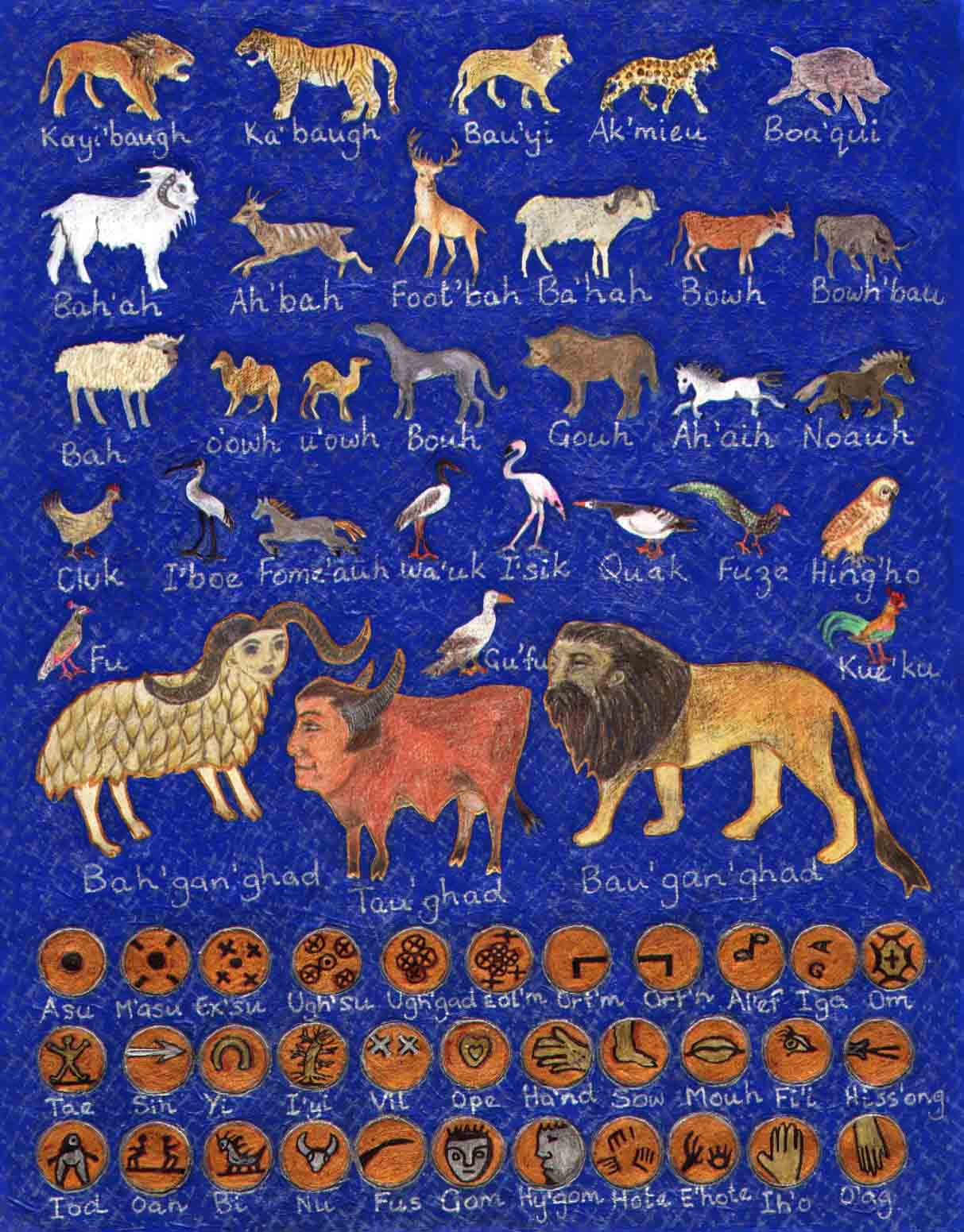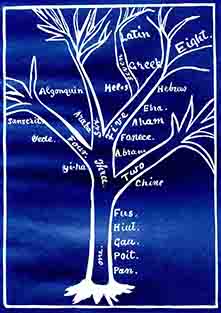Oahspe Study
LANGUAGES OF MAN Part 2
Tree of Language Development
|
|
|
|
|
Left: Se'moin Tablet; Middle: I'hin Tablet; Left: Biene Tablet. (Oahspe Images)
The first three tablets given to man during the development of the Panic language including Poit, Gau Hiut and Fus. |
Introducing the Tree of Language
The accompanying text to the Tree of Language (see image i031) in the Ancient Languages Section of the Book of Saphah in Oahspe (35/B), yields some detail on the progression of languagesit is, however, very general in scope. It is the purpose of this tract to further illume the subject.
The first constant to realize is that while language started with the Panic tongue and progressed as shown in the tree, nevertheless, Panic did not cease to be spoken even though Poit was developed, and Gau and Hiut, and so on. That is, even as today American, Chinese, Hindi, Arabic, etc., languages are spoken throughout the world, so too, in the past were different languages spoken in different places in the same period of time, the language depending upon the particular development of each tribe.
The first language, Panic, was guttural in character. Guttural means to speak from the gut or diaphragm. Panic was mostly more or less controlled grunting or regulated barking. As such, the vowels (e, o, i, u, a, y) played a large part in differentiating words, as did the guttural consonants and some palatals such as g, k, r, h, x, s. Dentals (the consonant sounds: d, t, n, l, j, z) were poorly developed and labials (p, f, b, v, w, m) the most difficult of all to pronounce.
Nevertheless, as we look at the language lists from Oahspe, we notice that the words attributed to each language contain some words which have the more difficult to pronounce consonants. Take for example the Panic word 'puh' (35/D.30) meaning capstan or to pull. We see linguistically that it is essentially a grunt that started with the lips closed and then exploding outward (pushing the air out through the lips)---not very difficult to pronounce. And that is precisely the point. Therefore, it would seem that while some phonemes and syllabic combinations are difficult, and therefore rare in usage, other phonemes and syllabic combinations are more easily uttered, and these latter make up the bulk of the Panic language.
|
|
Growth of the Tree of Language
The Language Tree shows Poit, Gau, Hiut and Fus languages as not changing the language paradigm/archetype/pattern presented by Panic, but rather shifting the paradigm. Thus, Poit, Gau, Hiut and Fus are simply extensions of the Panic language, adding variations and supplements as development allowed.
So Poit, which followed Panic, extended the language base by essentially adding new meanings through using new and more sounds by controlling the lips (labial sounds: p, f, b, v, w, m). So the development of labial sounds in Poit (see 35/B.4) must refer to extensive use of labial sounds, that is, to perfecting the use of the lips in sound.
Let us examine this in light of the earlier Panic. Consider a concept which has similar words with labials in them in both Panic, the first language of man, and Poit, the second language. For example, hand (35/D.69), in Panic is Pau (say it aloud now), an initial labial sound followed by an explosive guttural.---easily pronounced, little skill being required, nor much development necessary in vocal development (facial muscles, tongue, regulating larynx, diaphragm control, etc.). Along with a pointing finger to indicate that which is spoken about, the idea of 'hand' can be readily communicated, especially to those who had never heard the word previously. Contrast the skill needed to pronounce Pau with that required for the Poit word for hand, Pop (say it aloud now). Notice now the extra skill and controlled finesse required both with the restrained diaphragm movement and with use of the lips and facial control, especially with the final 'p'.
The Poit language came in the cycle of Sue, it was the language of rhythm --- of cadence--- of poetry --- of attempting to find unison with others, in the sense that this was the time that man learned to march together --- do rites and ceremonies. Speech was more for the effect, than the actual substance of the words themselves, in some sense. So when Gau followed Poit, Gau looked at the relationship between things, although in Sue's cycle man was encouraged to see relationships but had no way of substantiating them --- what is real and what is not real. In Apollo's cycle man began to see the patterns of Harmony, Symmetry and Music, and this was the objective experience of what man had experienced in the cycle of Sue. That is, in Sue's cycle they were subject to the flow, but in Apollo's cycle they began to see and comprehend the flow in terms of pattern resulting in harmony, symmetry, music and so forth.
Gau probably meant the proliferation of decisive words indicating comparison, magnitude, number, dimension, size, and the like. Most likely then, Gau language was brought into being for and by a people sufficiently developed as to keenly differentiate between things, to measure and weigh all things as to place and purpose. The Gau language was therefore useful for proving things, for developing and extending logic and reasoning and judgment in man. 35/B.1.5. Gau.*
* Gau is described in various places throughout Oahspe. From these we can perceive that the Gau language was meant to prove things, and to keenly differentiate between things. See for example, 11/3.64; 14/4.5; 18/12.5; 35/D.28. Thus: Gau was the first use of language to prove things, being the introduction of primitive logic into man's culture.
Here, in part, is how Oahspe (35/D.28) describes the Gau language: Gau, a geometrical language. Language is of two parts, the proven is Gau, the unproven is M'gau. || From this, and other evidence (Poit built depth using rites and ceremonies; Gau applied that depth built by Poit), we may deduce that the Gau language marked the introduction of primitive logic into the culture of man. Hence Gau was the first language used to prove things.
After Gau, came Hiut. According to 35/B.1.6, Hiut was the first acquiesced language. It is not further explained what this means. Perhaps it meant that those who spoke the language readily accepted with little to no protest, alterations and additions to the language, somewhat as most modern-day Americans do.
From the tree we can see that Fus came next in development. The language tree text says Fus was written word-signs. It is not wholly clear what is meant by this, for Se'moin, being Panic, was the first tablet with a symbol for each of its 121 words. And Bienei, given to the Poit people, also had an additional 33 word-signs. Also with the tablet of Bienei we are shown the animals that were named by the Poit, but evidently they had no written signs for them and we are simply shown modern drawings of the animals. Perhaps Fus was the time when word-signs were given to anything and everything as need arose.
In other words Fus represents the time of the first invented word signs (written words). Since the cycle of Thor was the time when the Ghans began to write words, we may tentatively set the beginning of the Fus language to that time period (17/1.1-11). Now according to the language tree, Fus was still essentially a Panic language, being a variant of it. In fact verse 17/1.10 said the language the Ghans used was called the Panic language (Ah-ce-o-ga).
The I'hin tablet's (i035) rudimentary character makes it obvious that it fits in within the first paradigm change, that is, an extension of the Panic language. Since we already have a Panic tablet (Se'moin) and a Poit tablet (Bienei), therefore the undated I'hin tablet is likely either a Gau, a Hiut, or a Fus tablet.
After Fus came the first branching of the language away from Panic roots. This undoubtedly indicates a major language-paradigm change.
In Part 3 we continue to follow the development of the Language Tree from the Chine Language which was the sixth major language of man.
All Oahspe references are from the Standard Edition Oahspe of 2007
●
GO TO NEXT ARTICLE:
The Languages of Man Part 3



